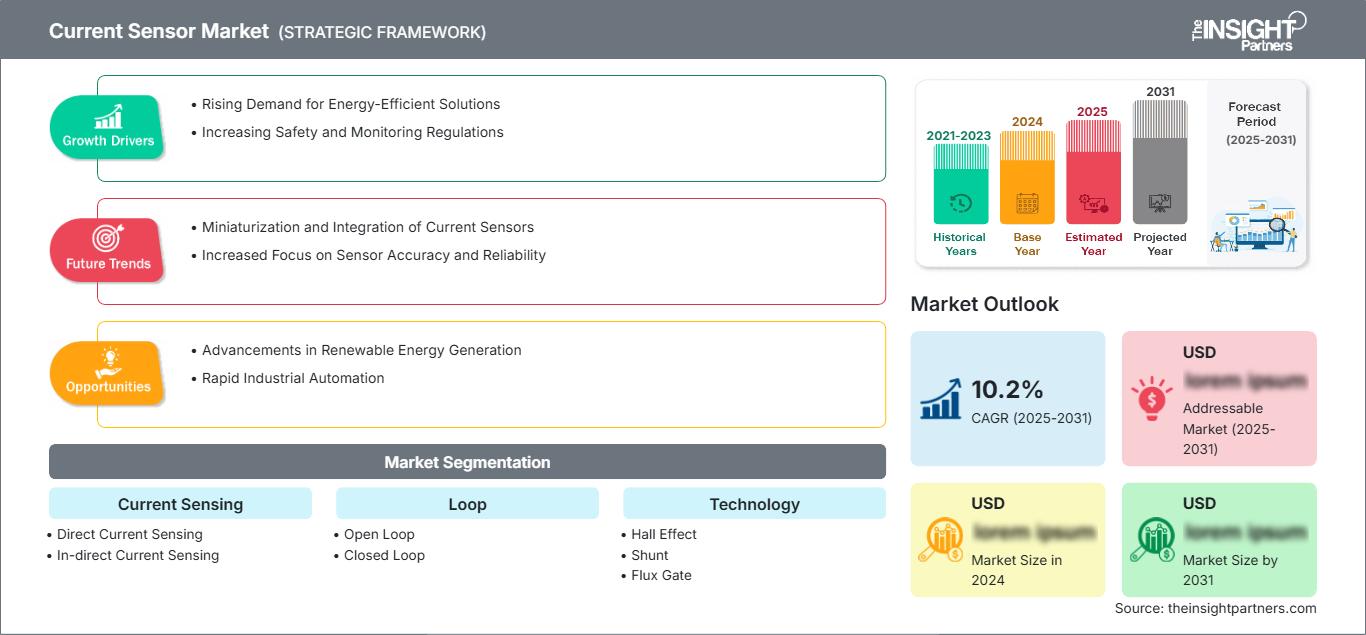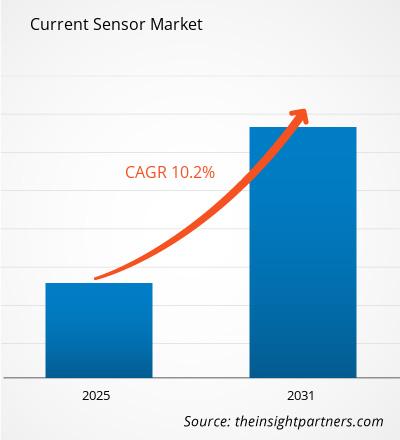Der Markt für Stromsensoren wird voraussichtlich zwischen 2025 und 2031 eine durchschnittliche jährliche Wachstumsrate (CAGR) von 10,2 % verzeichnen, wobei die Marktgröße von XX Millionen US-Dollar im Jahr 2024 auf XX Millionen US-Dollar im Jahr 2031 anwachsen wird.
Der Bericht ist segmentiert nach Strommessung (Gleichstrommessung, Indirektstrommessung), Schleife (offene Schleife, geschlossene Schleife), Technologie (Hall-Effekt, Shunt, Flux Gate, magnetoresistiv), Ausgang (analog, digital), Anwendung (Motorantrieb, Umrichter-Wechselrichter, Batteriemanagement, USV & SMPS, Starter & Generatoren, Netzinfrastruktur, Sonstige). Die globale Analyse ist weiter auf regionaler Ebene und nach wichtigen Ländern aufgeschlüsselt. Der Bericht bietet den Wert in USD für die oben genannte Analyse und Segmente.
Zweck des Berichts
Der Bericht „Markt für Stromsensoren“ von The Insight Partners zielt darauf ab, die aktuelle Situation und das zukünftige Wachstum sowie die wichtigsten treibenden Faktoren, Herausforderungen und Chancen zu beschreiben. Dadurch erhalten verschiedene Geschäftsinteressenten Einblicke, beispielsweise:
- Technologieanbieter/-hersteller: Um die sich entwickelnde Marktdynamik zu verstehen und die potenziellen Wachstumschancen zu kennen, sodass sie fundierte strategische Entscheidungen treffen können.
- Investoren: Um eine umfassende Trendanalyse hinsichtlich der Marktwachstumsrate, der finanziellen Marktprognosen und der Chancen entlang der Wertschöpfungskette durchzuführen.
- Regulierungsbehörden: Um Richtlinien und Überwachungsaktivitäten auf dem Markt zu regulieren, mit dem Ziel, Missbrauch zu minimieren, das Vertrauen der Investoren zu wahren und die Integrität und Stabilität des Marktes aufrechtzuerhalten.
Marktsegmentierung für Stromsensoren: Strommessung
- Gleichstrommessung
- Indirekte Strommessung
Schleife
- Offene Schleife
- Geschlossene Schleife
Technologie
- Hall-Effekt
- Shunt
- Flux-Gate
- Magnetoresistiv
Ausgang
- Analog
- Digital
Anwendung
- Motorantrieb
- Konverter-Wechselrichter
- Batteriemanagement
- USV & SMPS
- Starter & Generatoren
- Netzinfrastruktur
- Sonstiges
Sie erhalten kostenlos Anpassungen an jedem Bericht, einschließlich Teilen dieses Berichts oder einer Analyse auf Länderebene, eines Excel-Datenpakets sowie tolle Angebote und Rabatte für Start-ups und Universitäten.
Markt für Stromsensoren: Strategische Einblicke

- Holen Sie sich die wichtigsten Markttrends aus diesem Bericht.Dieses KOSTENLOSE Beispiel umfasst Datenanalysen, die von Markttrends bis hin zu Schätzungen und Prognosen reichen.
Wachstumstreiber für Stromsensoren
- Steigende Nachfrage nach energieeffizienten Lösungen: Da Nachhaltigkeit und Energieeinsparung weltweit im Vordergrund stehen, profitiert der Markt für Stromsensoren von der steigenden Nachfrage nach energieeffizienten Lösungen. Stromsensoren spielen eine entscheidende Rolle bei der Überwachung und Steuerung des Stromverbrauchs in verschiedenen Anwendungen, darunter Smart Grids und Systeme für erneuerbare Energien. Durch die präzise Messung des Stromflusses ermöglichen diese Sensoren Versorgungsunternehmen und Unternehmen, die Energieverteilung zu optimieren, Abfall zu reduzieren und erneuerbare Energiequellen effektiv zu integrieren. Der Trend zu Energieeffizienz dürfte Innovationen vorantreiben und die Verbreitung von Stromsensortechnologien vorantreiben.
- Zunehmende Sicherheits- und Überwachungsvorschriften: Ein weiterer wichtiger Treiber für den Markt für Stromsensoren ist die wachsende Zahl von Sicherheits- und Überwachungsvorschriften in allen Branchen. Regierungen und Aufsichtsbehörden setzen strengere Standards um, um die Sicherheit elektrischer Systeme und Geräte zu gewährleisten. Stromsensoren sind unerlässlich, um Überstromzustände zu erkennen, elektrische Fehler zu verhindern und die Systemzuverlässigkeit zu verbessern. Da Branchen wie die Automobilindustrie, die Luft- und Raumfahrt sowie die Fertigung der Einhaltung von Sicherheitsvorschriften höchste Priorität einräumen, wird die Nachfrage nach fortschrittlichen Stromsensorlösungen voraussichtlich steigen und zum Marktwachstum beitragen.
Markttrends für Stromsensoren:
- Miniaturisierung und Integration von Stromsensoren: Ein bedeutender Trend auf dem Markt für Stromsensoren ist die Miniaturisierung und Integration dieser Geräte. Hersteller entwickeln kompakte, leichte und hochintegrierte Stromsensoren, die sich problemlos in verschiedene Anwendungen integrieren lassen – von Unterhaltungselektronik bis hin zu Industrieanlagen. Dieser Trend wird durch den Bedarf an platzsparenden Lösungen und die wachsende Nachfrage nach nahtloser Integration von Sensortechnologien in intelligente und vernetzte Geräte vorangetrieben.
- Verstärkter Fokus auf Sensorgenauigkeit und -zuverlässigkeit: Da Stromsensoren für verschiedene Anwendungen von entscheidender Bedeutung sind, liegt ein zunehmender Schwerpunkt auf der Verbesserung ihrer Genauigkeit und Zuverlässigkeit. Hersteller investieren in Forschung und Entwicklung, um die Leistung von Stromsensoren zu verbessern, einschließlich der Entwicklung fortschrittlicher Sensortechnologien, verbesserter Signalverarbeitungsalgorithmen und robusterer Materialien. Dieser Trend ist besonders relevant für unternehmenskritische Anwendungen wie Stromnetze und die industrielle Automatisierung, wo eine präzise Stromüberwachung für einen sicheren und effizienten Betrieb unerlässlich ist.
Marktchancen für Stromsensoren
- Fortschritte bei der Erzeugung erneuerbarer Energien: Das schnelle Wachstum erneuerbarer Energiequellen wie Solar- und Windkraft ist ein wichtiger Treiber für den Markt für Stromsensoren. Stromsensoren sind für die Überwachung und Steuerung der Erzeugung, Verteilung und Speicherung erneuerbarer Energien unerlässlich und gewährleisten effiziente und zuverlässige Stromversorgungssysteme. Da Länder und Organisationen weiterhin in die Infrastruktur für erneuerbare Energien investieren, wird der Bedarf an fortschrittlichen Stromsensortechnologien weiter steigen und das Wachstum des Marktes für Stromsensoren vorantreiben.
- Schnelle industrielle Automatisierung: Der Markt für Stromsensoren wird maßgeblich durch den anhaltenden Trend zur industriellen Automatisierung in verschiedenen Branchen vorangetrieben. Da die Industrie nach höherer Betriebseffizienz, geringeren Arbeitskosten und höherer Produktivität strebt, ist die Nachfrage nach Stromsensoren stark gestiegen. Diese Sensoren ermöglichen die Echtzeitüberwachung und -steuerung elektrischer Systeme und ermöglichen Unternehmen so, den Energieverbrauch zu optimieren, die Gerätesicherheit zu gewährleisten und die Gesamtsystemzuverlässigkeit zu verbessern. Die zunehmende Verbreitung von Automatisierungstechnologien wie Robotik und IoT treibt den Bedarf an präzisen und zuverlässigen Strommesslösungen in der Fertigungs- und Prozessindustrie weiter voran.
Regionale Einblicke in den aktuellen Sensormarkt
Die Analysten von The Insight Partners haben die regionalen Trends und Faktoren, die den Markt für Stromsensoren im Prognosezeitraum beeinflussen, ausführlich erläutert. In diesem Abschnitt werden auch die Marktsegmente und die geografische Lage von Stromsensoren in Nordamerika, Europa, dem asiatisch-pazifischen Raum, dem Nahen Osten und Afrika sowie Süd- und Mittelamerika erörtert.
Umfang des aktuellen Sensormarktberichts
| Berichtsattribut | Einzelheiten |
|---|---|
| Marktgröße in 2024 | US$ XX million |
| Marktgröße nach 2031 | US$ XX Million |
| Globale CAGR (2025 - 2031) | 10.2% |
| Historische Daten | 2021-2023 |
| Prognosezeitraum | 2025-2031 |
| Abgedeckte Segmente |
By Strommessung
|
| Abgedeckte Regionen und Länder | Nordamerika
|
| Marktführer und wichtige Unternehmensprofile |
|
Aktuelle Marktteilnehmerdichte für Sensoren: Auswirkungen auf die Geschäftsdynamik verstehen
Der Markt für Stromsensoren wächst rasant. Die steigende Nachfrage der Endverbraucher ist auf Faktoren wie veränderte Verbraucherpräferenzen, technologische Fortschritte und ein stärkeres Bewusstsein für die Produktvorteile zurückzuführen. Mit der steigenden Nachfrage erweitern Unternehmen ihr Angebot, entwickeln Innovationen, um den Bedürfnissen der Verbraucher gerecht zu werden, und nutzen neue Trends, was das Marktwachstum weiter ankurbelt.

- Holen Sie sich die Markt für Stromsensoren Übersicht der wichtigsten Akteure
Wichtige Verkaufsargumente
- Umfassende Abdeckung: Der Bericht analysiert umfassend Produkte, Dienstleistungen, Typen und Endnutzer des Marktes für Stromsensoren und bietet einen ganzheitlichen Überblick.
- Expertenanalyse: Der Bericht basiert auf dem umfassenden Verständnis von Branchenexperten und Analysten.
- Aktuelle Informationen: Der Bericht gewährleistet Geschäftsrelevanz durch die Berichterstattung über aktuelle Informationen und Datentrends.
- Anpassungsoptionen: Dieser Bericht kann an spezifische Kundenanforderungen angepasst werden und passt sich optimal an die Geschäftsstrategien an.
Der Forschungsbericht zum Markt für Stromsensoren kann daher dazu beitragen, die Branchensituation und die Wachstumsaussichten zu entschlüsseln und zu verstehen. Obwohl es einige berechtigte Bedenken geben kann, überwiegen die Vorteile dieses Berichts tendenziell die Nachteile.
- Historische Analyse (2 Jahre), Basisjahr, Prognose (7 Jahre) mit CAGR
- PEST- und SWOT-Analyse
- Marktgröße Wert/Volumen – Global, Regional, Land
- Branchen- und Wettbewerbslandschaft
- Excel-Datensatz
Aktuelle Berichte
Verwandte Berichte
Erfahrungsberichte
Grund zum Kauf
- Fundierte Entscheidungsfindung
- Marktdynamik verstehen
- Wettbewerbsanalyse
- Kundeneinblicke
- Marktprognosen
- Risikominimierung
- Strategische Planung
- Investitionsbegründung
- Identifizierung neuer Märkte
- Verbesserung von Marketingstrategien
- Steigerung der Betriebseffizienz
- Anpassung an regulatorische Trends




















 Kostenlose Probe anfordern für - Markt für Stromsensoren
Kostenlose Probe anfordern für - Markt für Stromsensoren